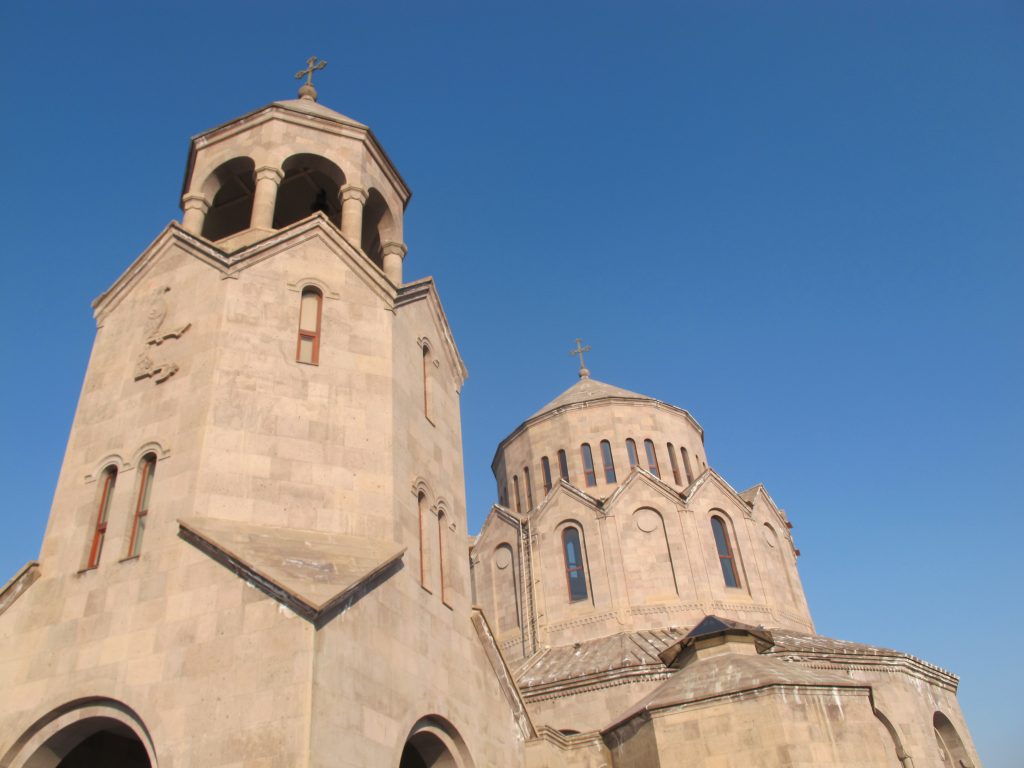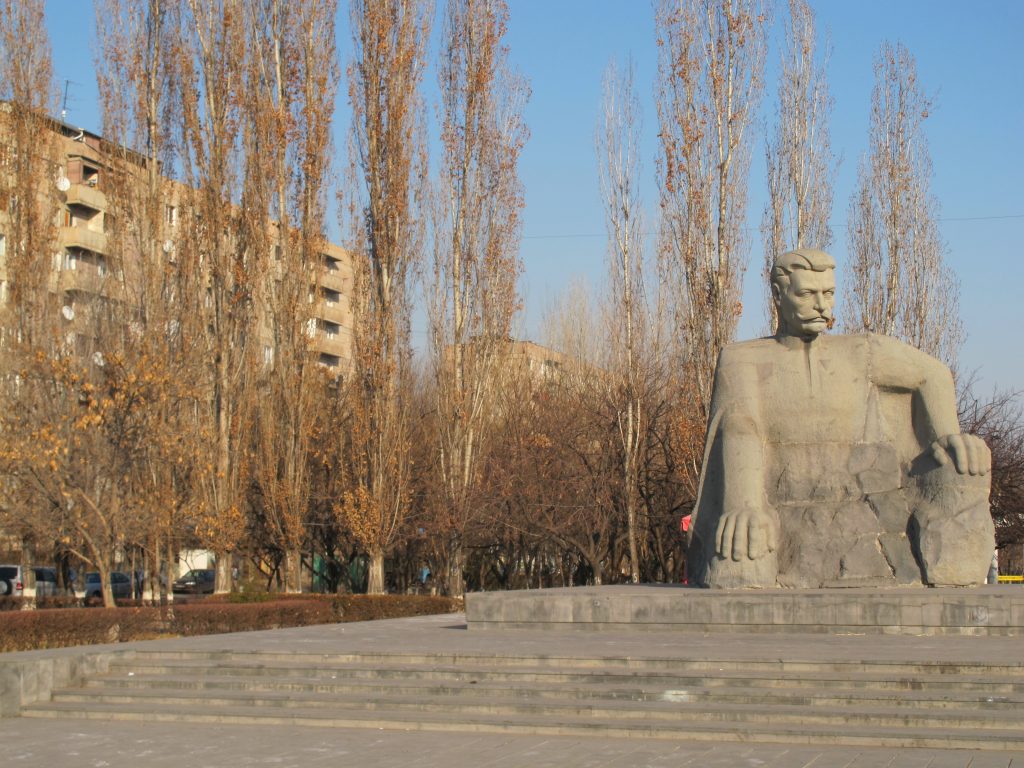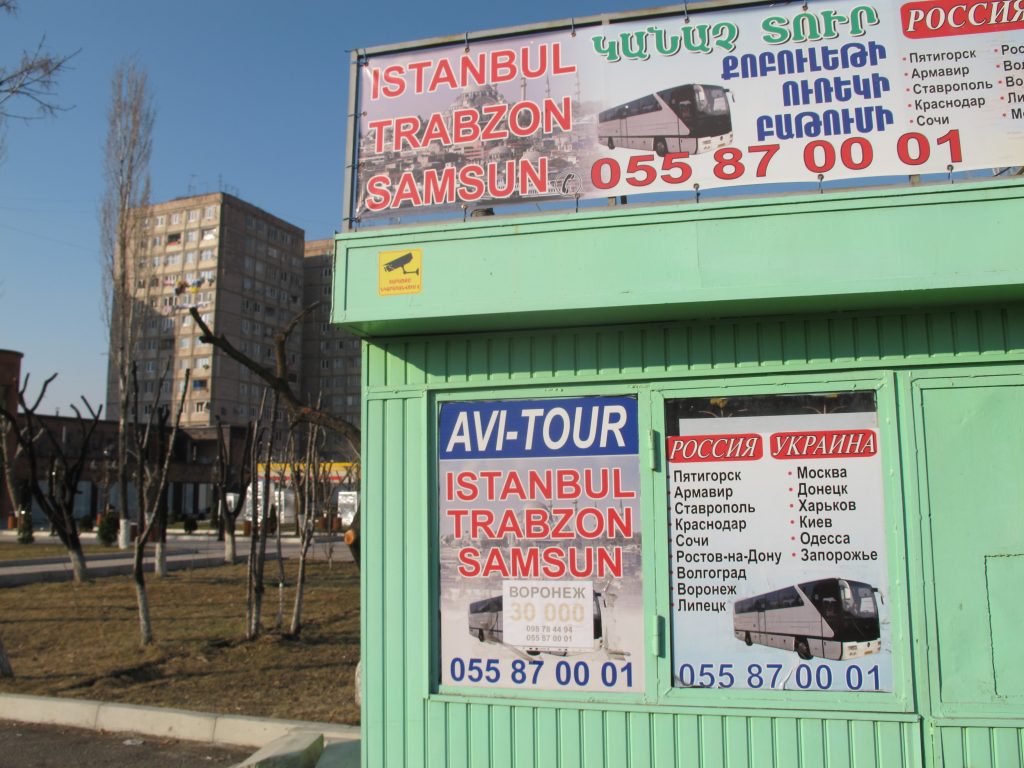Maxim Edwards is a journalist and student from the UK. He has worked in Tatarstan and Armenia, and he writes on inter-ethnic and inter-religious relations in the post-Soviet space. His work has been published with OpenDemocracy, Souciant, the Forward, Al-Jazeera and others.
On a cloudy day in February I took a Chinese minibus to Bangladesh. The forty-minute journey was uneventful. We passed the immense American Embassy (probably to its prior knowledge) and entered the suburbs; concrete tower blocks, roads of garages and streetside bakeries. We had entered Bangladeshi territory, unawares. As I sifted around for small change, my friend from the Netherlands was justifying his reasons to a fellow passenger for his fluent Armenian (in Armenian).
Yerevan’s sprawling Soviet suburbs such as Bangladesh are deeply connected to the Armenian experience in the twentieth century. A city of 29,000 in 1897 now counts over a million residents, and upon visiting Yerevan in 1932, Arthur Koestler saw it as “a kind of Tel Aviv, where the survivors of another martyred nation gathered to construct a new home.” From 1926 to 1939, its population increased by over 130,000. By 1959 this in turn had increased by over 300,000. The urbanisation of the early Soviet period and mass influxes of refugees had transformed the country. Some arrived here from Eastern Turkey shortly before the Red Army entered Yerevan in 1920, and others from the Armenian diaspora in the Middle East joined them in the late 1940s. Soviet Yerevan, the 1924 brainchild of architect Alexander Tamanian, would further expand, and its suburbs’ names commemorate cities from which Armenians fled nearly a century ago. Nork-Marash district, for instance, is named after the city of Kahramanmaraş in Southeastern Turkey.
Bangladesh is the name given to an area of Malatia-Sebastia district (population 141,900) in the Armenian capital of Yerevan. I had taken enough Armenian lessons to read the alphabet slowly. By the time I had read the destinations of the local marshrutkas [minibuses] for my commute, they were long gone, though I had noticed that some terminated in Bangladesh. To the bewilderment – and probably amusement – of local friends, I developed a strong desire to go there and see what this Bangladesh was all about.
Never having visited the Republic of Bangladesh, my reflections are probably missing a certain something. Nevertheless I began to ask about the suburb’s unofficial name. “Why is it called Bangladesh?” mimicked a colleague, incredulous. “Because it’s hot, poor, far away, and nobody knows much about it.” Sadly, it seemed that the nickname was pejorative, although anthropologist Lilit Mirzoyan, in a small article on Yerevan’s unofficial toponyms, had another explanation. The name arose around the time when Bangladesh gained its independence from Pakistan in 1971 after a vicious military campaign against Bengali nationalists. Mirzoyan also noted that there was a district known as Hindkastan (India), so called because the Hayreniq cinema often showed Indian films in the 1970s, those exiting the local metro station sometimes being greeted by music from the subcontinent. There was however no Pakistan amongst Yerevan’s suburbs; understandable given that Pakistan is one of a handful of countries which does not recognise Armenia as an independent state.

As may often be the case, these unofficial names developed in the relatively closed world of the Soviet Union, when personal contact with people from India and Bangladesh was extremely rare. In the independent Armenia of 2014 this is not strictly the case; some Indian and a few Bangladeshi students study in Yerevan, many of whom attend the medical university and are fluent Armenian speakers. They can at times be met in the bars of Parpetsi Street on Friday nights amongst the usual crowds – American-Armenians finding their roots, Lebanese-Armenian repatriates, and slurring, strawberry-nosed western European expats.
As anachronistic as it may seem to some, Armenian links with the Indian subcontinent – given their widespread diaspora communities – are long established. The first Armenian-language newspaper, Azdarar, was printed in Chennai in 1794. In Bangladesh (the Republic) itself, an Armenian Church from 1781 stands in the capital of Dhaka. A neighbourhood in Dhaka, Armanitola, commemorates their community. The treasury of the ancient cathedral in Echmiadzin, Armenia, is a testament to the wealth and sophistication of these communities, with artefacts from Armenian churches in Calcutta and Chennai.
Bangladesh itself is a fairly conventional Yerevan suburb. Australian sound recordist Martin Kay, who spent some time living in the district, appreciated the monolithic concrete Soviet architecture that blocked some of the din of the district and amplified others in the courtyards they formed. He recalled the “feeling of ten thousand eyes watching [him] from the apartments” as he walked around to record his environment. Bangladesh is not an area frequently of interest to foreigners. The area is mostly residential and supports two large markets. Yerevan businessman Samvel Alexanyan, whose nephew is district mayor, is said to hold sway over the area. Alexanyan has recently been at the centre of controversy over a Yerevan landmark, the much-loved Pak Shouka (covered market), which he has acquired and converted into a luxury supermarket, to public outrage. He also, according to local taxi drivers, owns a curious glass cube atop a desolate hill above the main road to Bangladesh. A popular restaurant around thirty years ago, it now stands derelict. As a friend from Belfast discovered after scrambling up the scree to investigate, its clientele are now mainly feral dogs.

Bangladesh’s key landmark is the immense circular Holy Trinity church, built in 2003 to commemorate the seventh-century cathedral of Zvartnots, whose ruins stand between Etchmiadzin and Yerevan. Zvartnots was destroyed, according to one of the notice boards at the archaeological site, “either by an earthquake or the Arabs” (the two possibly seen as synonymous). The replica church’s bell-tower is emblazoned with the Armenian letter Է, representing God –- and hopefully this time -– eternity. The new church is well visited by locals; its dome echoes with their whispers. “Do not kiss the frescoes” urges one sign. “It is strictly forbidden to converse with the candle-seller,” commands another. Both are obeyed, with grave devotion. Outside, a noticeboard outlines the church’s history and a local priest, Ter Yesayi (Father Yesayi) muses on the meaning of love. What is the difference between loving and being in love? A toddler runs in ever decreasing circles around a column whilst her young parents look on with weary smiles. They seem to be contemplating the ominous and holy letter Է.
We walk on, along Raffi Street and past a colonnade monument in the centre of a roundabout in honour of every letter in the Armenian alphabet. Zoravar Andranik, the famous General, reads them from across the street. A shuttered shop advertises Avi-Tour, buses to three Turkish cities – Istanbul, Trabzon, and Samsun. Southern Russia and Eastern Ukraine are also within reach – Krasnodar, Sochi, Pyatigorsk, Kharkov and Donetsk. Getting out of Bangladesh has never been easier. We are stared at – “What are you staring at?” one might ask, but only a fool would pretend he didn’t know and only a liar would claim that he hadn’t come here to stare back. Passing a handsome and now derelict piece of modernist Soviet architecture I raise my camera to take a photo and a passing man tuts audibly. I feel deeply ashamed; we all come to places such as these to see decay. To call it anti-tourism as some do is merely to excuse it.

We walk through a warren of carpets and emerge in the market for which Bangladesh is best known to Yerevan locals. It sells all manner of Useful Household Things – taps, screwdrivers, ironing boards, homemade wine, Armenian pop music. We enter a small kebab restaurant near the car appliances section. I take a lamb kebab. Yes mis chem utum (I don’t eat meat), says my friend. He is presented with a skewer of potatoes, which I suspect he may not have enjoyed. We sit in a back room with tiled floors and plastic furniture and make conversation. Silva, in her early forties, prepares coffee and opens up. She earns just 3,000 dram (approximately 7 USD) a day, “chopping the meat, cleaning up, everything.” She had moved to Yerevan a few years ago from Sisian in Southern Armenia after the death of her husband. Why is the area called Bangladesh? “After the place in India, you mean?” she replies. She doesn’t really know, but whatever it’s called, people are leaving it. There’s just no work anymore.
At this point Alik comes in, forty-something, pointy-shoed and leather-jacketed. He pours himself one of quite a number of vodkas and scrutinises us from across the room. “If it wasn’t for Armenia” he declares, pointing a trembling finger, “you wouldn’t be here.” Assuming this was the first sign of patriotism ready to be vented, I responded in kind. But of course! Armenia, a beautiful, ancient country! The first Christian country. Did you know that X, Y, and even Z were Armenians? He howls with laughter and dismisses this with a wave of his cigarette. “No, no, no. I mean, you’re obviously interested in Armenia… so that’s why you came here, right?”

Alik’s Russian slowly slid into Armenian, and my Armenian-speaking friend took over the conversation. Our new friend was surprised. He broke off his sentence, arched an eyebrow and contemplated us again.
“You’re not… Mormons are you?” No, we were not.
“Just that… there are a lot of young foreign guys in Armenia who speak good Armenian and work for those sects, for those… missionaries,” he spat. “But Armenia has her own church, an ancient church, the first church. So we don’t need any of that.”
He leaned in, conspiratorially, and added “one hundred percent – one hundred percent – of the American Embassy staff here are Mormon”
We say our goodbyes and run into Silva who smiles at us knowingly. “Don’t mind Alik, all he does is talk. He’s a good sort really.” I ask to take a photo and she is happy to oblige. “No problem! I’m used to it. Whenever we have Iranians here, they always want to take a photo. Iranians with cameras.”
That, I felt, was a subject best left to the Mormons at the American Embassy.
Leaving Bangladesh, we walk through the Agricultural Market on Vantian Street, through rows of Ladas with open boots of wholesale fruits. Somebody is carrying several hundred plastic bags, a few rows across, on a wooden pole. They rustle in the wind, a banner of war, as their owner trips up and starts an argument. Farmers from villages as far as Lake Sevan, Armenians, Yezidis, and Molokans, come here to sell their produce. There are imported goods too; six months ago the plentiful crates of tomatoes and oranges from Turkey would have amazed me. Yet the closed border means little, and indirect trade from Turkey, via Georgia, to Bangladesh and elsewhere in Armenia is commonplace.

Leaving Bangladesh, I remembered the district’s official name: Malatia-Sebastia, after the modern Turkish cities of Malatya and Sivas. Those places might conceivably seem distant to many in Armenia today. Although those cities each have Armenian heritages (Houshamadyan has wonderful archives of Ottoman Malatya and Sivas both), these unique threads of Armenian life have become but a weave of a 21st-century understanding of Armenianness
Like Armenian Dhaka, Malatya and Sivas could also seem poor, and — after a century of injustice — little known and perhaps unrecognizable (though it would not be proper in Armenia to admit it). As a name, Bangladesh seemed preferable. And all of a sudden, Malatia-Sebastia, this “poor, distant, and little known place,” began to make a lot more sense.












6 comments
Thats a very good and inspiring article. I quite liked it. Nice to read how people perceive other countries even though they never seen it. Cool travel article. thanks for sharing.
Really fascinating to know bangladesh in another country with resemblance to my motherland.wanna visit this bangladesh.
Thanks for this great article. I didn’t know about Bangladesh in Armenia. I hope to visit it some day.
Amazing article. I am surprised. Hope to see Armenia one day. Love and respect to Armenians.